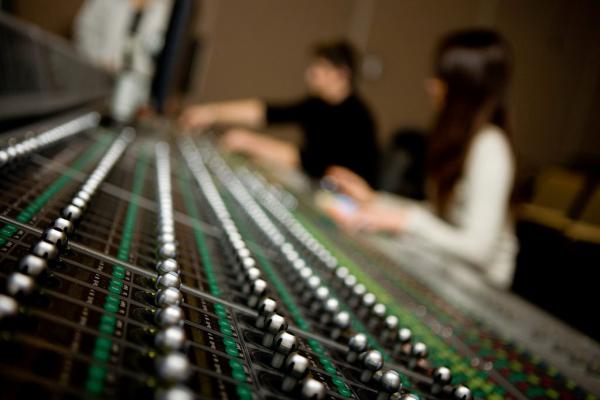3 Fundamental Ways of Adding Sound to Film
By David Freudenberg | 20-May-2020

The perfect camera, the right lens, and the best lighting. All these elements play an essential role in the filmmaking process. None of them draw in an audience like sounds and effects. When we’re watching horrors, it's the sound intensity that keeps us at the edge of our seats, alerting us to how close the killer is to their victim.
With love stories, it's the soft, warm music that creates a wave of emotions bringing tears to our eyes. Sound brings life to a film and makes an audience feel like they are part of it. Here are 3 ways to add sound to film:
1. Using Diegetic Sounds
The term 'diegesis' originates from Greek and means 'to narrate'. With respect to film, it refers to a story told on screen. Diegetic sounds are the actual sounds picked up while filming, that the characters in the film can hear. They bring a film to life and are the most important audio elements for any production.
Types of Diegetic Sounds
- Actors speaking to each other (character dialogue)
- Sounds from on-screen objects. For example, the sound of car tires screeching while a character is driving, or the sound of a character shutting a door.
- The music coming from an instrument like a piano, or a sound system. Also, music from a choir or orchestra in the film.
Some scenes may require the sound to be recorded after and not during the action. For example:
- A fight scene doesn't sound dramatic enough, so the sound editor will amp up the sound of punches, falls, and breaking objects for a better impact.
- Dialogue between characters sounds muffled, so the actors will re-record in post-production. This is also known as Automated Dialogue Replacement (ADR).
- The director did not record some lines of dialogue while shooting so they have to re-record them.
2. Using Non-Diegetic Sounds
The source of non-diegetic sounds is invisible on the screen and the characters can't hear it. Sound editors record these sounds separately and insert them in the film post-production. Filmmakers use non-diegetic sounds to support the film and give viewers a satisfying experience.
Types of Non Diegetic Sounds
- Narration - The character tells the story as it unfolds in the film. This is primarily for the viewers' benefit. A great example is the successful 2013 film 'The Wolf of Wall Street'. The character Jordan Belfort gives an explicit account of his illegal operations on Wall Street.
- An original score - This is a piece of instrumental music written and composed for a specific film. It can be electronic, choral or orchestral. The score begins and ends at specific points during the film to enhance the drama and capture the audience’s emotions.
- Sound effects - They make the scenes in the film louder and more dramatic. For example, in scenes where several actions are taking place simultaneously.
If two characters are fighting on a fast-moving train, the noise from the train will drown out the sound from the fight. Sound effects to the fighting scene make it louder and lure the audience.
3. Using Foley Sound
Some sounds cannot be recorded adequately on set. For example, the sound of footsteps or cloth movement may not project audibly enough for the film. That’s where Foley sounds come in. They make the sounds more realistic and immersive.
In the 1920s, sound effects artist Jack Donovan Foley developed a unique sound effect technique where he recorded sounds with tools around him. He would record the sounds in synchrony with the film to enhance audio quality.
His techniques are still relevant today. Foley artists create realistic sound effects using physical props. The sound editors then add them to the film post-production. The sound engineers and editors develop the complex sounds that Foley artists cannot create, for example, the sound of a car engine.
How Do Foley Artists Create Sounds?
Foley recording studios house multiple surfaces, objects, and textures to create various sounds. First, the artists will watch the film while noting the sounds they'll need to recreate. Then they'll collect all the props they need. In the past, Foley artists would project the film onto a screen and record the sound timing it perfectly. Now, they can record separately and also enhance their sound with editing software.
Types of Foley Sounds
- Footsteps - Creating this sound is not as straightforward as it seems. Foley artists have a variety of shoe types and floor surfaces. They must use specific types of shoes on a particular type of surface to create the required footstep sounds for a film. They can create the sound of stiletto heels on a wooden floor or boots on a sidewalk.
- Character Movement - Subtle or not, multiple sounds come from character movement. For example, the sound of clothes when a character is putting on their jacket, brushing past or hugging another character and cross-legging in their jeans.
- Props - Both foley artists and sound editors can create these sounds. Foley artists mainly create sounds from props that characters generally work with. For example, unsheathing a sword, phone ringing, wooden floor creaking, cigarette inhaling, and removing a bullet from a wound.
Conclusion
Seeing as sound affects the emotions and entertainment experience of the audience, it's not an element to be taken lightly. These three fundamental ways of adding sound to film play a huge role in producing a lasting impression in the minds and hearts of audiences world over.
Comments

